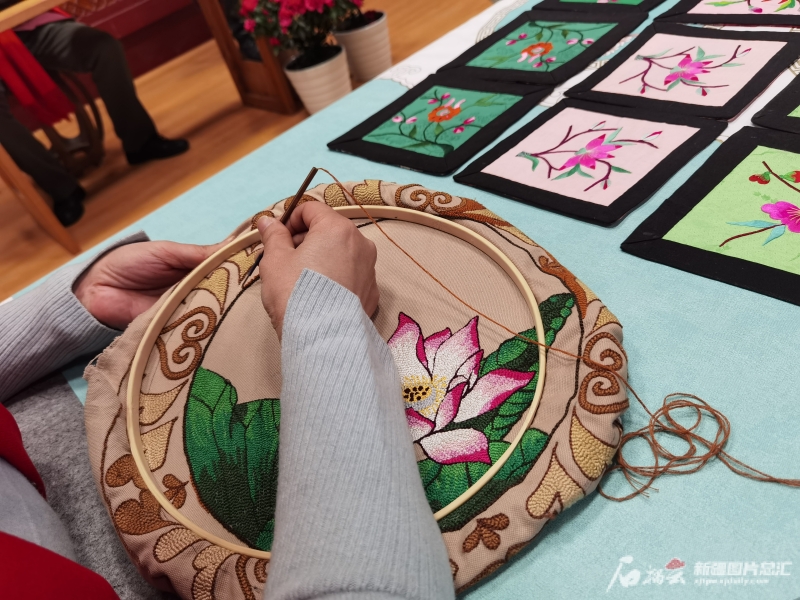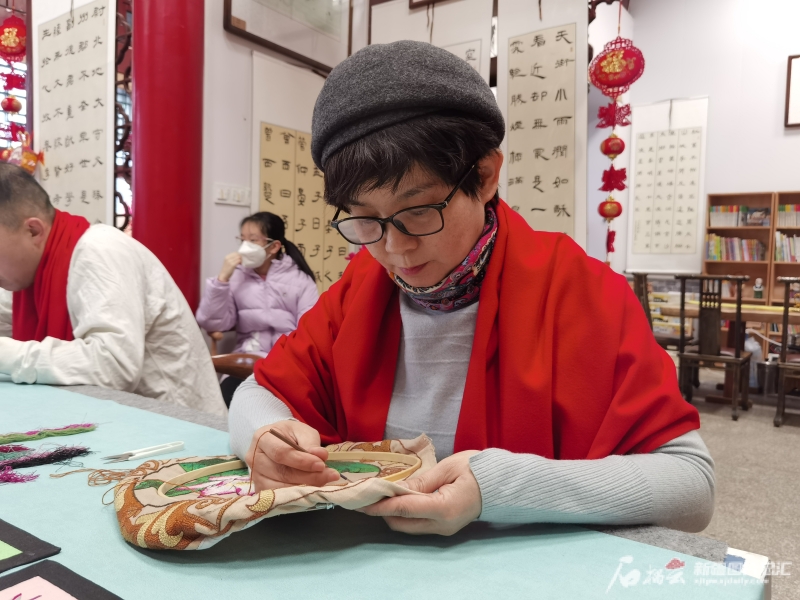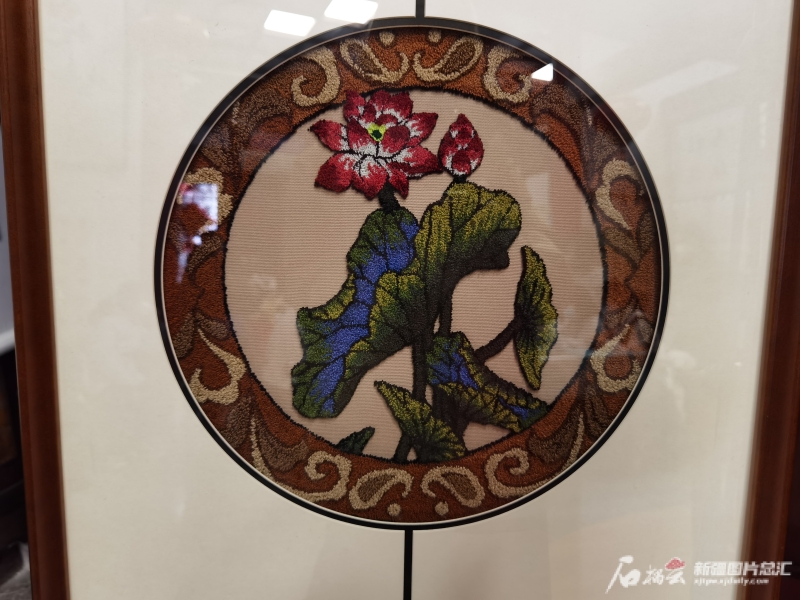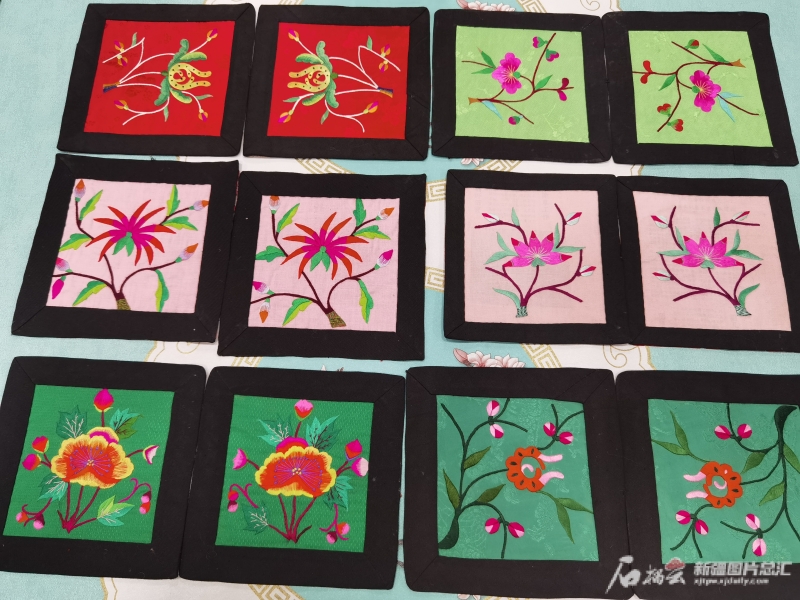Colorful silk threads fluttered up and down, and a lifelike embroidery work of lotus was completed by Ma Qingjie, a master of arts and crafts in Xinjiang. On January 14, 2023, many inheritors of intangible cultural heritage showed their "unique skills" to celebrate the Year of the Rabbit at the “Xinjiang Is A Wonderful Land -- The 10th Spring Festival Custom Exhibition of Intangible Cultural Heritage in the North and South of the Tianshan Mountains”.

Photo shows Ma Qingjie embroiders. (Shiliuyun- Xinjiang Daily/ Liu Mengmeng)
“My sister Ma Qingyue is the inheritor of Hui costume in Urumqi municipal intangible cultural heritage project, and I am the inheritor of Hui embroidery in Xinjiang intangible cultural heritage project. We combined embroidery and costume together and set up a costume embroidery incubation base,” Ma Qingjie said.
Ma Qingjie said that their mother would make some embroideries that require simple skills, and growing up under the influence of their mother, they would play with embroidery needles and silk threads while other children were playing with dolls. After graduating from junior middle school, they ran a tailor shop, which was named "Sister Tailor Shop".

Photo shows Ma Qingjie embroiders. (Shiliuyun- Xinjiang Daily/ Liu Mengmeng)
“At that time, I went to a costume design school in Urumqi City to learn professional knowledge on tailoring. When I came back, we divided the work. I focused on clothing design and tailoring, and my sister focused on embroidery.” Ma Qingyue said that there was a time when they took the trouble to remove stitches for many times just to make a perfect collar for a perfect pure silk shirt in accordance with the design. In order not to bring the damage to the clothes, they removed stitches with their hands, and their fingers were swollen and turned red after alterations for several times.
“Later, we wanted to use traditional embroidery on clothing, so I studied with my husband's aunt,” Ma Qingjie said. At the beginning, Ma Qingjie didn’t know the quintessence of embroidery, and her fingers suffered greatly. It took her two years to master the stitching skills of traditional embroidery. Every time she saw her customers looking smarter with the embroidery embellishments on their cuffs and collars, Ma Qingjie felt a great sense of achievement.
Later, Ma Qingjie and her sister set up Shengshihuaer Culture and Technology Co., Ltd., and set up an embroidery clothing base, adopting the business mode of ‘companies+cooperatives+farmers’, to encourage rural women to work and start businesses through free training and equipment support. Nowadays, there are more than 20 embroiderers working here.

Photo shows Ma Qingjie’s embroidery work Lotus. (Shiliuyun- Xinjiang Daily/ Liu Mengmeng)
Yan Xiaofang, an embroiderer, began to learn clothing making from the sisters since 2000. Now she has mastered the skills and established a cooperative. “Now we have a lot of orders and more students. The people who get the products will know this traditional skills, and the traditional skills can be better passed on.”
They actively innovate and find better ways to fit intangible cultural heritage to the market. In recent years, Ma Qingyue has begun to develop a private customization of hand-embroidered cheongsam, and also being engaged in handmade clothing for infants and young children. She has also actively researched and developed embroidery tourism handicrafts, and the products sell well.
Ma Qingjie has developed her own style as she learned from Qian Meirong, the First Master of Chinese Embroidery Art, and has integrated Suzhou embroidery with Xinjiang embroidery. In 2013, on the Second Skills Contest held by the Xinjiang Uygur Autonomous Region Women’s Federation, Ma Qingjie triumphed with an embroidery work of peony as the best. Subsequently, she was titled as ‘the master of arts and crafts in Xinjiang’.

Photo shows Ma Qingjie’s embroidery work. (Shiliuyun- Xinjiang Daily/ Liu Mengmeng)
“Embroidery can show the charm of Chinese traditional culture. To inherit traditional skills, we should do something new based on tradition, so that intangible cultural heritage can be integrated into our lives. We hope that our works can make everyone happy in the Spring Festival,” Ma Qingjie said.
(A written permission shall be obtained for reprinting, excerpting, copying and mirroring of the contents published on this website. Unauthorized aforementioned act shall be deemed an infringement, of which the actor shall be held accountable under the law.)









